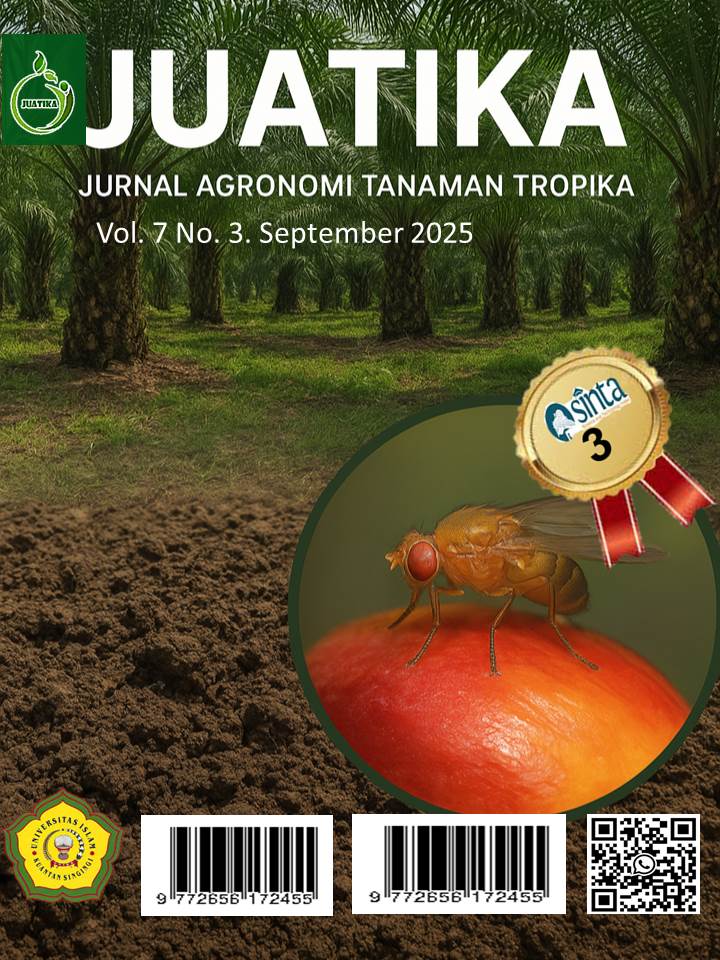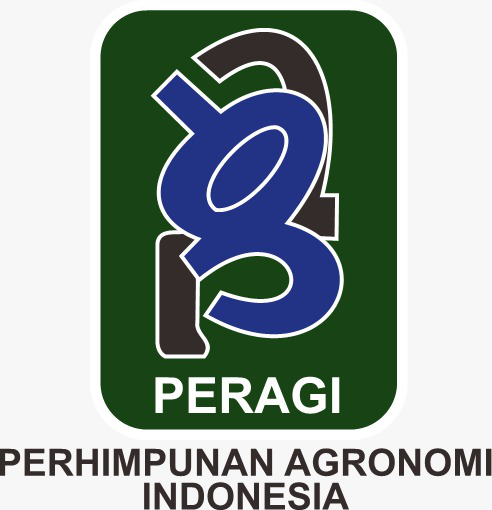Analysis of Peat Soil Characteristics (Histosol) at Several Maturity Levels in Oil Palm (Elaeis guineensis Jacq.) Plantations in Lubuk Sakat Village, Kampar
Abstract
Agricultural development on peatlands requires a careful and thoughtful approach. Therefore, conducting an inventory of their characteristics is essential for ensuring proper utilization and effective planning. This study aims to analyze the characteristics of peat soils in Lubuk Sakat Village, Kampar, Riau, which are planted with oil palm at various maturity stages, covering a potential peatland area of approximately 800 hectares. The research was conducted using observational and descriptive methods, with purposive sampling employed at peatlands of fibric, hemic, and sapric maturity stages. The observed soil characteristics included pH, organic carbon (C-Organic), available phosphorus (P-Available), and cation exchange capacity (CEC). In addition to these chemical properties, the soil microbial population was also assessed. The results revealed that soil pH, C-Organic, and CEC were similar across the three maturity stages, while P-Available was higher in sapric and hemic peat compared to fibric peat. The microbial population was found to be highest in sapric peat, followed by hemic peat, and lowest in fibric peat. These findings are expected to provide a solid foundation for managing fertilization and improving oil palm productivity on peatlands with similar characteristics.
Downloads
References
A. S. Hanafiah, Sabrina, T., & Guchi, H. (2005). Biologi dan ekologi tanah. USU Press.
Afrianti, S., Sitorus, R. G., & Zainal, D. E. (2023). Analisis sifat fisik tanah gambut pada perkebunan kelapa sawit PTPN 4 Ajamu II Meranti Paham. Perbal: Jurnal Pertanian Berkelanjutan, 11(3), 327–335.
Balai Penelitian Tanah. (2009). Petunjuk teknis analisis kimia tanah, tanaman, air, dan pupuk (2nd ed.). Badan Penelitian dan Pengembangan Pertanian.
Dania Ayushinta, R., Herlambang, S., & Arbiwati, D. (2021). Hubungan kematangan gambut dengan kadar lengas terhadap emisi karbon dioksida (CO₂) pada gambut Kalimantan Tengah. Jurnal Tanah dan Air (Soil and Water Journal), 18(1), 11–20. http://jurnal.upnyk.ac.id/index.php/jta/index
Darmosarkoro, W., Harahap, I. Y., & Syamsuddin, E. (2001). Pengaruh kekeringan pada tanaman kelapa sawit dan upaya penanggulangannya. Warta PPKS, 9(3), 83–96.
Ditjen Pengendalian Pencemaran dan Kerusakan Lingkungan, Kementerian Lingkungan Hidup dan Kehutanan. (2017). Kesatuan hidrologis gambut nasional (Skala 1:250.000).
Iwan Sasli. (2011). Karakterisasi gambut dengan berbagai bahan amelioran dan pengaruhnya terhadap sifat fisik dan kimia guna mendukung produktivitas lahan gambut. Agrovigor, 4(1), 42–50.
Maipa Dia Pati, Anwar, S., Widyastuti, R., & Dadang. (2016). Studi populasi mikrob fungsional pada tanah gambut yang diaplikasikan dua jenis pestisida. Jurnal Sains Hayati, 2(1). http://biologi.ipb.ac.id/jurnal/index.php/jsdhayati
Mukhlis, Sariffudin, & Hanum, H. (2011). Kimia tanah: Teori dan aplikasi. USU Press.
Page, S. E., Rieley, J. O., & Banks, C. J. (2011). Global and regional importance of the tropical peatland carbon pool. Global Change Biology, 17(2), 798–818. https://doi.org/10.1111/j.1365-2486.2010.02279.x
Page, S., & Banks, C. J. (2007). Tropical peatlands: Distribution, extent and carbon storage—Uncertainties and knowledge gaps. Retrieved from https://www.researchgate.net/publication/239531431
Rizky Alviodinasyari, A., Martina, A., & Lestari, W. (2015). Pengendalian Ganoderma boninense oleh Trichoderma sp. SBJ8 pada kecambah dan bibit kelapa sawit (Elaeis guineensis Jacq.) di tanah gambut. JOM FMIPA, 2(1), 99–107.
Sabiham, S., & Sukarman, D. (2012). Pengelolaan lahan gambut untuk pengembangan kelapa sawit di Indonesia. Jurnal Ilmu Tanah dan Lingkungan, 12(1), 1–10.
Sari, V. I., Dalimunthe, B. A., Harahap, F. S., & Walida, H. (2022). Analysis of peat soil chemical properties in oil palm plantation in Simpang Kanan Village, Rokan Hilir Regency. Jurnal Agronomi Tanaman Tropika (JUATIKA), 4(2), 283–288. https://doi.org/10.36378/juatika.v4i2.1939
Servais, S., Kominoski, J. S., Charles, S. P., Gaiser, E. E., Mazzei, V., Troxler, T. G., & Wilson, B. J. (2019). Saltwater intrusion and soil carbon loss: Testing effects of salinity and phosphorus loading on microbial functions in experimental freshwater wetlands. Geoderma, 337, 1291–1300. https://doi.org/10.1016/j.geoderma.2018.11.013
Supriyanto, S., Purwanto, P., Poromarto, S. H., & Supyani, S. (2022). Hubungan karakteristik biologis gambut dengan penyakit busuk batang yang disebabkan Ganoderma pada kelapa sawit. Perkebunan dan Lahan Tropika, 11(1), 1. https://doi.org/10.26418/plt.v11i1.53357
Wahyunto, Dariah, A. I., Pitono, D., & Sarwani, M. (2013). Prospect of peatland utilization for oil palm plantation in Indonesia. Perspektif, 12(1), 11–22.
Yuningsih, L., Bastoni, B., Yulianty, T., & Harbi, J. (2019). Sifat fisika dan kimia tanah pada lahan hutan gambut bekas terbakar: Studi kasus Kabupaten Ogan Komering Ilir, Sumatera Selatan, Indonesia. Sylva: Jurnal Ilmu-Ilmu Kehutanan, 8(1), 1. https://doi.org/10.32502/sylva.v8i1.1854
Copyright (c) 2025 Patra Anjara Ginting, Wawan, Fifi Puspita, Cynthia Bernadetta Silalahi, Asri Cahyati Zebua

This work is licensed under a Creative Commons Attribution 4.0 International License.
Authors who publish with Jurnal Agronomi Tanaman Tropika (JUATIKA) agree to the following terms:
Authors retain copyright and grant the Jurnal Agronomi Tanaman Tropika (JUATIKA) right of first publication with the work simultaneously licensed under a Creative Commons Attribution License (CC BY 4.0) that allows others to share (copy and redistribute the material in any medium or format) and adapt (remix, transform, and build upon the material for any purpose, even commercially) with an acknowledgment of the work's authorship and initial publication in Jurnal Agronomi Tanaman Tropika (JUATIKA).
Authors are able to enter into separate, additional contractual arrangements for the non-exclusive distribution of the journal's published version of the work (e.g., post it to an institutional repository or publish it in a book), with an acknowledgment of its initial publication in Jurnal Agronomi Tanaman Tropika (JUATIKA). Authors are permitted and encouraged to post their work online (e.g., in institutional repositories or on their website) prior to and during the submission process, as it can lead to productive exchanges, as well as earlier and greater citation of published work.







 More Information
More Information


